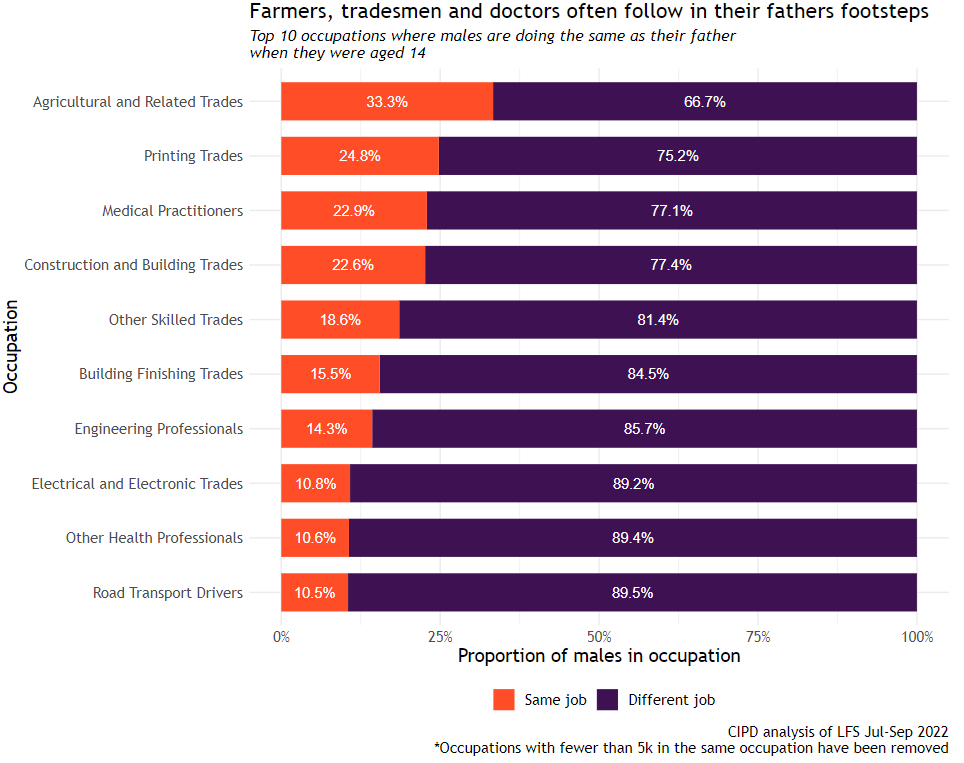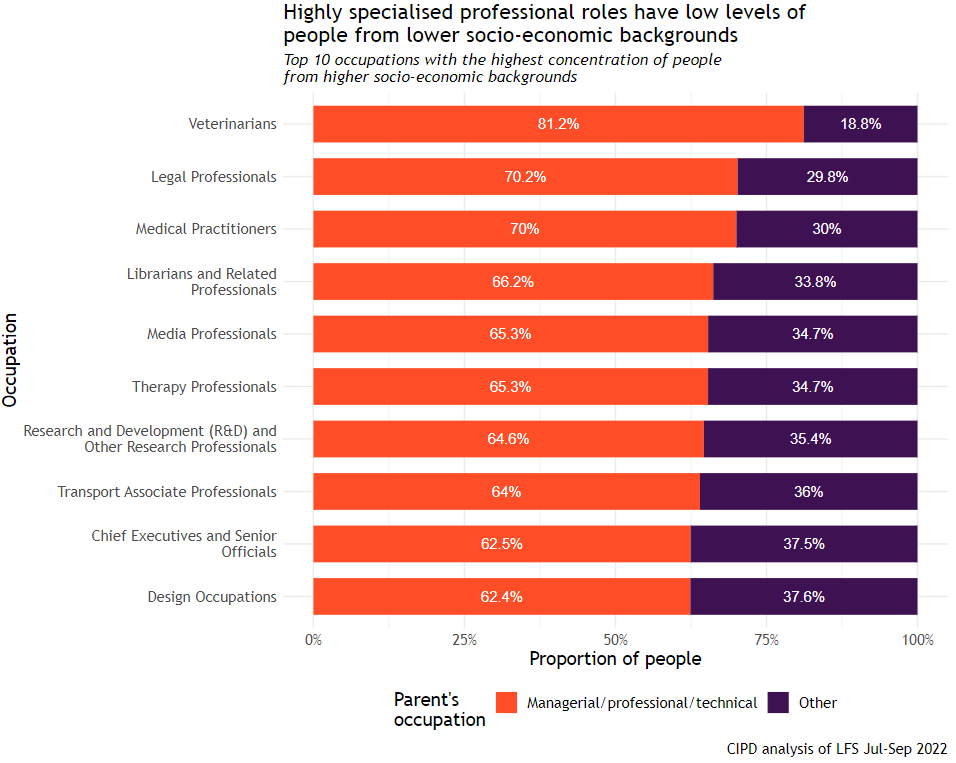Do you remember being asked what you want to be when you grow up? The answer might have been 'just like mum or dad'. Children idolise their parents. DfE research showed that young people found the information, advice and guidance (IAG) received from their family to be more useful than the IAG they received from teachers.
This article uses data to answer the question of how many people actually follow in the footsteps of their parents. We compare peoples’ jobs with that of the main earner in their household when they were aged 14 (henceforth known as parent breadwinner).
Nearly a million people in the UK (973,376) do the same job as their parent breadwinner.
The five largest occupations are as follows:
Source: Labour Force Survey July - September 2022
There are almost 100,000 teachers who are children of teachers in the UK. In fact, this is likely to be a gross underestimation as it excludes those where the teacher parent was not the breadwinner. This will be common due to rates of part-time working among female teachers.
After teachers, there are two roles where it is not uncommon for occupations to be replicated. Over 75,000 in construction and building trades and 66,000 of those in agriculture have gone on to do the same as their parent breadwinner. One in ten road transport drivers do the same job as their parent breadwinner. This figure is one in five for medical practitioners.
Apart from teachers, many of these occupational groups are male dominated. In total 5.4% of men work in the same role as the main earning parent, compared to just 3.2% of women. This is unsurprising given three quarters (74%) of respondents had main earners who were fathers, when they were 14.
124,013 women work in the same occupation as their mothers (who were breadwinners). The largest groups are teachers (24,423), carers (21,303), sales assistants (12,321), nurses (10,736) and cleaners (10,045). Given there notably female breadwinners in the sample, unfortunately it is not possible to reliably present the following chart for women.
Where boys follow in the footsteps of their fathers?
Looking at jobs where men follow suit shows that one in three (33%) currently working in agricultural trades do the same as their fathers. A number of tradesmen also often train and work in the same job as their fathers. This ranges from one in ten electricians to one in four of those in printing trades. Bricklayers, roofers, plumbers, carpenters, furniture makers make up somewhere between the two. Almost a quarter of male medical practitioners have followed the same route as their fathers. Becoming engineers is also common among boys of male engineers.

Is this such a bad thing? Having a parent who is in/previously worked in a similar role means they will be able to offer advice and support. They may be well connected, and if they are passing down a business this is helpful in succession planning. Also, consider the impact on labour supply if all those teachers’ parents hadn’t talked about their experiences in the job?
There are some negatives though. The support just might not be relevant anymore as 'it’s not like it was in the old days'. And parental influence can almost go so far as parental pressure. But are some people using their parents connections and knowledge to gain an unfair foothold in hard-to-enter industries and becoming so called 'nepo-babies'?
Which jobs have low levels of social mobility?
Parental occupation is often used in studies of social mobility and is used to measure socio-economic background. Some jobs have high levels of people from high socio-economic backgrounds. These roles are often high paid, highly specialised professional roles some of which take years of training (at a high cost). These include vets; lawyers, barristers, solicitors and judges; GPs, consultants, surgeons and scientists in R&D.
Among vets, for example, 8 in 10 are from a higher socio-economic class. Veterinary courses are seen to have some of the lowest rates of social mobility, defined by a combining whether someone was in receipt of FSM and whether they reached the highest 20% of earnings of their cohort.
In the UK, three-quarters of applicants to study medicine have a parent in the highest occupational socio-economic group. With lack of awareness of medical education and careers, particularly among those without expertise at school at home or a barrier to widening participation.
In other roles, such as journalists (under media professionals in the chart), nearly two-thirds are from a high socio-economic background. With some using their role to talk about the personal challenges they have faced coming from a working class background in a profession, it is unsurprising to see the highest paid roles, CEOs in this list.

There is recognition of poor socio-economic diversity in some professions. For example, the professional association that represents solicitors, the Law Society has dedicated resources to monitor and improve social mobility. There must however be an understanding that this cannot change overnight.
To help improve social mobility across workplaces in the UK, the government has published guidance for employers. Two highlights which organisations need to improve on:
- Remove barriers that are limiting access to talent
By ensuring hiring practices do not create barriers for people from lower socio-economic backgrounds. E.g., basing hiring decisions or sifting based on qualifications can exclude disadvantaged applicants who may not have had the best opportunities but who could thrive. Asking for a qualification should only be used if it is essential to the role. Competency or skill-based questions at interview allow candidates to draw from a broad range of experiences. - Collect socio-economic and diversity data from employees and potential candidates
Understanding who works for and applies to roles in your organisation enables you to be in a good position to build a road map for the future. This then enables you to target interventions for improving social mobility among your workforce. Use benchmarking as a data driven exercise to understand how your workforce compares to national figures on socio-economic background, but also to other organisations in your sector.
In summary, it is clear nepo-babies exist, but it's not always amongst the most privileged. There are pros and cons to working in the same or similar job as your parents. The infiltration of some professions is however still worrying when it comes to social mobility. It is the government’s responsibility to improve IAG, and widen participation in certain courses in HE to tackle this.
Topics A-Z
Browse our A–Z catalogue of information, guidance and resources covering all aspects of people practice.
Bullying
and harassment
Discover our practice guidance and recommendations to tackle bullying and harassment in the workplace.
About the author

James Cockett, Labour Market Economist

Explore the CIPD’s point of view on religion and belief, including actions for Government and recommendations for employers

Explore the CIPD’s point of view on age diversity in the workplace, including recommendations for employers and actions for the UK Government

Explore the CIPD’s point of view on gender equality at work, including recommendations for employers and actions for the UK Government

Peter Cheese, the CIPD's chief executive, looks at the challenges and opportunities faced by today’s business leaders and the strategic priorities needed to drive future success

We outline the key pieces of legislation set to come into force in the UK and explain their implications for employers and employees

We examine people’s desired hours and how this compares to the hours they actually work

Employers’ reactions to pension proposal highlight concerns over cost, while the CIPD calls for focus on raising pension awareness among staff, the need for higher contributions and better understanding of value for money
